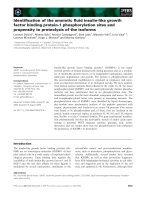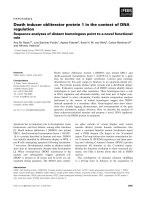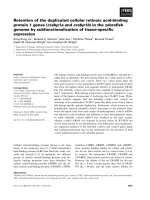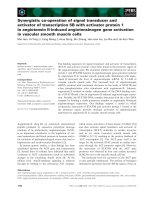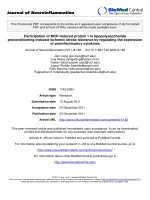Proline rich acidic protein 1 in life and death r6
Bạn đang xem bản rút gọn của tài liệu. Xem và tải ngay bản đầy đủ của tài liệu tại đây (1.3 MB, 75 trang )
145
to overexpress PRAP1 before subjecting them to 5-FU treatment. Lysates were
harvested and immunoprecipitation were carried out using antibody against Hsp
70. The immunoprecipitated proteins were then analyzed by western blotting. As
shown in Figure 3.72, PRAP1 and Hsp 70 coprecipitated. PRAP1 was detected in
Hsp 70 precipitates. These data demonstrated that Hsp 70 interacted with PRAP1
and were present in the same complex upon 5-FU treatment.
3.12 Role of PRAP1 in apoptotic cells
In our study, we observed that PRAP1 was highly expressed in both
differentiated cells as well as stress-induced apoptotic cells. In addition, the
protein PRAP1 was found to bind to the surface of bacteria cells. We
hypothesized that PRAP1 may also bind to the surface of apoptotic cells and may
play a role in the clearance of apoptotic cells.
3.12.1 Induction of PRAP1 expression in apoptotic cells
To further validate the expression of PRAP1 in apoptotic cells, we used
HT 29 cells which have high basal levels of PRAP1 protein expression. Briefly,
HT 29 cells were treated with 5mM sodium butyrate for 48 hours to induce
apoptosis. Cell culture medium containing dead cells that were detached from the
culture flask were harvested. The live cells that remained attached to the culture
flask were harvested by trypsinization. Cells were stained with propidium iodide
and subjected to flow cytometry for analysis of DNA content. Our results showed
that the population of the attached cells in sub-G1 was comparable to that of the
untreated control (Figure 3.72). On the other hand, the floating cells showed a
significant increase in the sub-G1 population. This indicated that the floating cells
were composed of mainly dead cells.
146
Figure 3.72 Dying cells in floating population
Representative histogram showing HT 29 cells untreated (control) or treated with
5mM sodium butyrate for 48 hours. Floating cells (Floating) from the treated
sample were harvested separately from the adherent cells (Adherent). All cells
were fixed and stained with propidium iodide and DNA content was analyzed by
flow cytometry. Box indicates cells at Sub-G1 (dying cell population).
147
To further validate the apoptotic nature of these floating cells, we
employed the annexin V-FITC staining assay. Annexin V is a phospholipid
binding protein that has a high binding affinity for phosphatidylserine (PS) that
translocates from inner to outer leaflet of plasma membrane during early
apoptosis. As shown in Figure 3.73, there was a shift of the fluorescent peak to the
right in the floating cells as compared to that of the adherent cells. There was
minimal annexin V staining in the adherent cells, as indicated by a lack of shift in
the fluorescent peak when compared to that of the untreated control. The
population of cells with positive annexin V staining was calculated by setting the
gating at R1 as shown in Figure 3.73. In the floating cells, 83% of cells were
positive for annexin V expression, while only 14% of adherent cells and 12% of
the untreated control were positive. These results demonstrated that the majority
of the floating cells were apoptotic cells, suggesting that we have successfully
obtained two distinct populations of cells, the live cells (attached cells) and the
apoptotic cells (floating cells).
The expression of PRAP1 in these two populations was analyzed. Our
results showed that PRAP1 mRNA was highly induced in the apoptotic cells as
compared to the adherent cells (Figure 3.74-A). Consistent with an increase at the
mRNA level, PRAP1 protein was also increased in the apoptotic cells (Figure
3.74-B). These results showed that PRAP1 expression was highly induced in
apoptotic cells compared to the live cells.
3.12.2 PRAP1 binds to the surface of apoptotic cells
As PRAP1 is a secreted protein, we investigated whether PRAP1 binds to
the surface of the apoptotic cells. Apoptotic cells were harvested and either
labeled with anti-PRAP1 antibody directly or fixed with 4% paraformaldehyde,
148
Figure 3.73 Apoptotic cells in floating population
Representative histogram showing annexin-V staining in HT 29 cells after
treatment with 5mM sodium butyrate for 48 hours or untreated (blue). Floating
cells (green) and attached cells (red) from the treated sample were harvested
separately. All cells were fixed and stained with annexin-V conjugated to FITC
and analyzed by flow cytometry. R1 gates the population of cells with positive
annexin-V staining.
Figure 3.74 PRAP1 expression is increased in apoptotic cells
A: Representative figure showing the relative expression level of PRAP1 mRNA
level in the adherent (control) and floating (Apoptotic cells) of HT 29 cells after
treatment with 5mM sodium butyrate for 48 hours.
B: Representative western blot of PRAP1 and GAPDH (loading control) of the
adherent (control) and floating (Apoptotic) population of HT 29 cells after
treatment with 5mM sodium butyrate for 48 hours.
proteins were detected on the surface of both unfixed and fixed apoptotic cells
(Figure 3.75). The staining was not homogenous, with some cells showing weak
detection of PRAP1 whereas others with strong detection of PRAP1. This
149
followed by immunofluorescence staining with PRAP1 antibody. Our results
showed that PRAP1 observation was confirmed using flow cytometry. As shown
in Figure 3.76, there were two populations of cells as indicated by two peaks
(shaded in red). Those cells with higher PRAP1 (black arrow) on the surface were
detected by a right shift as compared to the IgG control. There was a population
with no or little detection of PRAP1 (red arrow). This observation was further
confirmed to be not cell line specific. We repeated the experiment in another cell
line, HCT 116. Briefly, HCT 116 was treated with 3mM sodium butyrate and
apoptotic cells were harvested after 48 hours for immunofluorescence staining.
Consistent with our previous finding, PRAP1 was detected on the surface of
apoptotic cells (Figure 3.77). Together, our results showed that PRAP1 was
induced in the apoptotic cells and bound onto the surface of the apoptotic cell.
The binding of PRAP1 on the surface of apoptotic cells were confirmed
using two additional methods: direct immunofluorescence and transmission
electron microscopy. In the direct immunofluorescence assay, apoptotic cells were
fixed and incubated with recombinant HisPRAP1 protein conjugated to Alexa
fluor dye. Our results showed that exogenous PRAP1 was detected on the surface
of apoptotic cells (Figure 3.78). Both free dye and BSA conjugated to Alex fluor
dye were not detected on the surface of apoptotic cells. In the transmission
electron microscopy (TEM) assay, apoptotic cells were fixed, stained with
PRAP1-specific antibody and detected using secondary antibody conjugated to
gold particles. Cells were processed for TEM and pictures were taken. As shown
in Figure 3.79, there were gold particles, as indicated by the red arrows, detected
on the
150
Figure 3.75 Immunofluorescence images showing the binding of PRAP1 to
the surface of apoptotic cells
Representative immunofluorescence images of PRAP1 binding to the floating
population of HT 29 cells after treatment with 5mM sodium butyrate for 48 hr.
Floating cells were either unfixed or fixed in 4% paraformaldehyde and
immunofluorescence was performed by incubating with anti-PRAP1 antibody
(1:200) for 1 hour, followed by secondary anti-rabbit antibody conjugated to
Alexa Fluor 488 dye (Green).
Figure 3.76 Histogram showing PRAP1 binds to the surface of apoptotic cells
Representative histogram of PRAP1 (shaded in red) and rabbit IgG isotype
(unshaded) staining in floating population of HT 29 cells after treatment with
5mM sodium butyrate for 48 hours. Cells were either fixed or unfixed in 4%
paraformaldehyde. Red arrow indicates the fluorescence peak with unstained
population. Black arrow indicates fluorescence peak with positive staining.
151
Figure 3.77 PRAP1 binds on the surface of HCT 116 apoptotic cells
Representative immunofluorescence images of PRAP1 binding to apoptotic HCT
116 cells after treatment with 5mM sodium butyrate for 48 hours.
Figure 3.78 Alexa fluor labeled HisPRAP1 binds directly to the surface of
apoptotic cells
Representative immunofluorescence images of floating population of HT 29 cells
obtained after treatment with 5mM sodium butyrate for 48 hours incubated with
alexa fluor labeled HisPRAP1 (PRAP1) or free alexa fluor dye. Images were
taken using Confocal microscope.
152
Figure 3.79 Transmission electron microscopy of PRAP1 on apoptotic cells
Representative transmission electron microscopy (TEM) images of apoptotic HT
29 cells stained with PRAP1 antibody. PRAP1 protein is indicated by red arrows
and apoptotic bleb is indicated by black arrow.
153
outer surface of the membrane. One gold particle was detected on the surface of a
bleb (as indicated by a black arrow). These data showed for the first time that
PRAP1 binds on the outer surface of cell membrane of apoptotic cells.
3.12.3 PRAP1 enhanced the phagocytosis of beads
As we have shown previously that PRAP1 binds to the surface of bacteria,
we investigated whether the presence of PRAP1 on the surface of apoptotic cells
would affect their clearance by phagocytosis. To achieve that, we used
FluoSpheres polystyrene with yellow-green fluorescence. Briefly, these
microspheres were either coated with HisPRAP1, BSA or uncoated. These coated
beads were then incubated with a monocytic cell line, U937. Microspheres that
were not ingested by U937 cells were quenched. Population of cells with ingested
beads was measured by flow cytometry. Figure 3.80-A showed the representative
pictures of scatter-histogram plot analysis of phagocytosis of beads. Cells with
ingested beads are gated (as indicated by the circle) and percentage of cells with
ingested beads was calculated and summarized in Figure 3.80-B. Coating of
PRAP1 onto the surface of microspheres significantly enhanced their uptake by
U937. At as early as 15 min, coating of PRAP1 resulted in more than 3-fold
increase in the ingestion of the microspheres as compared to the BSA coated
microspheres control (16% vs 4%). After 1 hour, microspheres coated with
PRAP1 were ingested by about 50% of the cells while only 13% of cells had
ingested the BSA coated microspheres.
To mimic the in vivo system, we differentiated the monocytic cell line,
U937 into a macrophage lineage by treating it with dibutyryl cyclic adenosine
monophosphate (dcAMP). As shown in Figure 3.81, these macrophages were
154
Figure 3.80 Flow cytometry analysis of phagocytosis of beads by U937
Representative scatter plot of phagocytosis of beads (A). Fluorescent beads
uncoated or coated with BSA or HisPRAP1 were incubated with U937 cells and
phagocytosis were analyzed with flow cytometry. U937 cells with ingested
fluorescent beads were positive with fluorescent and gated (circle) and expressed
as a percentage of total cells (B). Number on top of column indicates the mean.
Columns, mean of 3 replicates; Bars, SE.
155
Figure 3.81 HisPRAP1 enhances phagocytosis of beads by macrophages
Representative figure showing the percentage of macrophages with ingestion of
beads after incubating with beads alone or beads coated with BSA or HisPRAP1
(Prap) for 20, 40, 60 and 90 minutes. Number on top of each column indicates
mean. Columns, mean of three replicates; Bars, SE.
156
more phagocytic than their undifferentiated parental cells. At as early as 20 min,
these macrophages ingested more than 2-fold of uncoated beads as compared to
undifferentiated U937 cells (11% vs 5%). Consistent with our finding, PRAP1
coated microspheres significantly enhanced the phagocytosis process by more
than 3-fold as compared to BSA coated microspheres (35% vs 9%). The results
suggest that cells undergoing apoptosis increase the secretion of PRAP1 which
binds on the surface of the apoptotic cells, which may enhance the clearance of
these cells by increasing the phagocytosis of apoptotic cells by macrophages.
3.13 Role of PRAP1 in a disease model, SLE
3.13.1 Detection of PRAP1 autoantigen
As there is growing evidence for an impairment of clearing apoptotic cells
in mouse models of SLE (Taylor, Carugati et al. 2000; Licht, Dieker et al. 2004)
and in humans (Herrmann, Voll et al. 1998; Baumann, Kolowos et al. 2002), we
hypothesized that PRAP1 may play a role in the clearance of apoptotic cells in this
disease. Since SLE is characterized by the presence of autoantigens and
autoantibodies, we examined the presence of PRAP1 protein and its autoantibody
in the serum of SLE patients. As shown in Figure 3.82-A, PRAP1 protein was
detected in the serum of both normal and SLE patients. The concentration of
PRAP1 in SLE patients was heterogeneously distributed. There were 28% of SLE
patients with higher PRAP1 protein (mean ± 2SD) detected in the serum as
compared to the normal (18 out of 65, Figure 3.82-B). There were 13% of SLE
patients with lower PRAP1 level and two of the patients had ten-fold less PRAP1
compared to the normal individuals.
157
Figure 3.82 PRAP1 protein was detected in the serum of both normal and
SLE patients
A: Scatter plot showing the distribution of PRAP1 protein level in serum. Level of
PRAP1 protein in the serum of normal individuals and SLE patients was assayed
by ELISA. HisPRAP1 was used as a standard to calculate the amount of PRAP1
protein present in the serum.
B: Summary of the ELISA data showing two populations of SLE patients
expressing lower or higher PRAP1 than the normal individual. Column, mean;
Bar, SE. * p<0.001
158
3.13.2 Detection of PRAP1 autoanitbodies
To detect PRAP1 autoantibodies, HisPRAP1 was used as antigen in an
ELISA assay. Majority of SLE patients had similar level of PRAP1 autoantibodies
as that of the normal individuals (Figure 3.83-A). The mean of the PRAP1
autoantibodies in SLE patients was slightly higher than that of the normal and not
significant (Figure 3.83-B). There were 11% of SLE patients (9 out of 85)
showing highly elevated PRAP1 autoantibodies (mean + 2SD). The specificity of
these autoantibodies was verified by western blot. Briefly, HisPRAP1 protein was
loaded unto SDS-PAGE gel and transferred unto nitrocellulose membrane and the
membrane was probed with serum from three SLE patients with either high or low
autoantibody titer. Consistent with our ELISA result, only serums from patients
with high titer of PRAP1 autoantibodies were able to detect HisPRAP1 on the
nitrocellulose membrane (Figure 3.84). Moreover, the band was specific as
compared to that of the positive control. These results confirmed the titer of the
PRAP1 autoantibody as measured by ELISA, and the autoantibodies detected
were specific against PRAP1. These results showed that PRAP1 autoantibodies
are present in the serum of both normal and SLE patients.
3.13.3 PRAP1 and proinflammatory cytokines
As PRAP1 autoantigens and autoantibodies were detected in SLE patients,
we investigated whether PRAP1 plays a role in immune cells interaction. To
achieve this, we used ELISA to measure some of the common proinflammatory
cytokines (TNFα, IL-6 and IL-1β) that are associated with acute inflammation.
Briefly, monocytes were stimulated by activated T-cells to produce cytokines. In
this study, we activated Jurkat
159
Figure 3.83 PRAP1 autoantibody was detected in serum
A: Scatter plot showing the distribution of PRAP1 autoantibodies level in serum.
Level of PRAP1 autoantibodies in the serum of normal individuals and SLE
patients was assayed by ELISA. OD50 was calculated for each individual samples
using the GraphPad software.
B: Summary of the OD50 of PRAP1 autoantibody obtained for both the normal
and SLE patients. Column, mean; Bar, SE.
160
Figure 3.84 Verification of PRAP1 autoantibodies in the serum
Representative western blot of HisPRAP1 detected using the PRAP1
autoantibodies in the serum of SLE patients. Lane 1: polyclonal anti-PRAP1
antibody; Lane 2-4: SLE patients with high titer of PRAP1 autoantibodies; Lane
5-7: SLE patients with low titer of PRAP1 autoantibodies.
161
cells with PHA/PMA, fixed them and co-cultured with monocytes (U937) in the
presence of various concentration of HisPRAP1. Supernatant were harvested after
48 hours and cytokines were assayed by ELISA. As shown in Figure 3.85, U937
cells were not able to produce cytokines by themselves or when co-cultured with
unstimulated Jurkat cells. Activated Jurkat cells were fixed and shown not to be
producing any cytokines. Upon co-culture with activated Jurkat cells, U937
produced high amount of proinflammatory cytokines. However, addition of
HisPRAP1 at low concentrations ranging from 1ng/ml to 200ng/ml did not result
in any significant changes in the production of the proinflammatory cytokines.
This observation was similar with higher concentration of HisPRAP1 ranging
from 500ng/ml to 10,000ng/ml (Figure 3.86). These results suggest that PRAP1
does not play a role in regulating immune cells interaction.
3.13.4 PRAP1 expression in PBMC
To study whether PRAP1 expression is differentially regulated by
lymphocytes from normal and SLE patients, we isolated PBMC from the blood of
15 normal individuals and 40 SLE patients. RNAs were extracted and the level of
PRAP1 expression in the PBMC of both normal and SLE patients were measured
by quantitative real-time RT-PCR. There were about 90% of SLE patients (36 out
of 40) with lower expression of PRAP1 as compared to that of the normal
individuals (Figure 3.87-A). The expression of PRAP1 was reduced significantly
by more than 2-fold when compared to that of the normal individuals (Figure
3.87-B). This observation was consistent with our hypothesis that the absence of
PRAP1 may play a role in the impairment of clearance of apoptotic cells as
observed in SLE.
162
TNF-a production
0
1000
2000
3000
4000
5000
6000
7000
M U U/P
200
U/P
100
U/P 50 U/P 10 U/P 1 Tc Tc/U Tc/U/P
200
Tc/U/P
100
Tc/U/P
50
Tc/U/P
10
Tc/U/P
1
Ts Ts/U Ts/U/P
200
Ts/U/P
100
Ts/U/P
50
Ts/U/P
10
Ts/U/P
1
Sample Name
TNF-a conc (pg)
IL-6 production
0
200
400
600
800
1000
1200
1400
1600
M U U/P 200 U/P 100 U/P 50 U/P 10 U/P 1 Tc Tc/U Tc/U/P
200
Tc/U/P
100
Tc/U/P
50
Tc/U/P
10
Tc/U/P
1
Ts Ts/U Ts/U/P
200
Ts/U/P
100
Ts/U/P
50
Ts/U/P
10
Ts/U/P
1
Sample Name
IL-6 conc (pg)
IL-1B production
0
200
400
600
800
1000
1200
1400
1600
1800
M
U
U/P 200
U/P 100
U/P 50
U/P 10
U/P 1
Tc
Tc/U
Tc/U/P 200
Tc/U/P 100
Tc/U/P 50
Tc/U/P 10
Tc/U/P 1
Ts
Ts/U
Ts/U/P 200
Ts/U/P 100
Ts/U/P 100
Ts/U/P 50
Ts/U/P 1
Sample Name
IL-1B conc (pg)
Figure 3.85 Effects of low concentration of HisPRAP1 protein on the
production of proinflammatory cytokines
Jurkat cells were activated by PHA/PMA, fixed and cocultured with U937 in the
presence or absence of HisPRAP1 (1, 10, 50, 100 and 200ng/ml). Production of
proinflammatory cytokines (TNFα, IL-6 and IL-1β) was measured by ELISA. M,
media alone; U, U937 cells; Tc, Unstimulated Jurkat cells; Ts, activated Jurkat
cells; Tc/U, Tc cocultured with U; Ts/U, Ts co-cultured with U; Tc/U/P, Tc/U in
the presence of HisPRAP1; Ts/U/P, Ts/U cultured in the presence of HisPRAP1.
Amount of each proinflammatory cytokines were calculated based on their
respective standard curve. Column, mean of three replicates; Bar, SE.
163
TNFa production
0
1000
2000
3000
4000
5000
6000
7000
M U U/P
10000
U/P
5000
U/P
1000
U/P
500
Tc Tc/U Tc/U
10000
Tc/U/P
5000
Tc/U/P
1000
Tc/U/P
500
Ts Ts/U Ts/U/P
10000
Ts/U/P
5000
Ts/U/P
1000
Sample Name
TNFa conc (pg)
IL-6 production
0
200
400
600
800
1000
1200
1400
M U U/P
10000
U/P
5000
U/P
1000
U/P
500
Tc Tc/U Tc/U
10000
Tc/U/P
5000
Tc/U/P
1000
Tc/U/P
500
Ts Ts/U Ts/U/P
10000
Ts/U/P
5000
Ts/U/P
1000
Ts/U/P
500
Sample Name
IL-6 conc (pg)
IL-1B production
0
200
400
600
800
1000
1200
1400
1600
M U U/P
10000
U/P
5000
U/P
1000
U/P
500
Tc Tc/U Tc/U
10000
Tc/U/P
5000
Tc/U/P
1000
Tc/U/P
500
Ts Ts/U Ts/U/P
10000
Ts/U/P
5000
Ts/U/P
1000
Ts/U/P
500
Sample Name
IL-1B conc (pg)
Figure 3.86 Effects of high concentration of PRAP1 on the production of
proinflammatory cytokines
Jurkat cells were activated by PHA/PMA, fixed and co-cultured with U937 in the
presence or absence of HisPRAP1 (500, 1000, 5000 and 10,000 ng/ml).
Production of proinflammatory cytokines (TNFα, IL-6 and IL-1β) was measured
by ELISA. M, media alone; U, U937 cells; Tc, Unstimulated Jurkat cells; Ts,
activated Jurkat cells; Tc/U, Tc co-cultured with U; Ts/U, Ts co-cultured with U;
Tc/U/P, Tc/U in the presence of HisPRAP1; Ts/U/P, Ts/U cultured in the presence
of HisPRAP1. Amount of each proinflammatory cytokines were calculated based
on their respective standard curve. Column, mean of three replicates; Bar, SE.
164
Figure 3.87 PRAP1 mRNA expression is reduced in SLE patients
A: Representative figure showing the relative expression level of PRAP1 mRNA
in the PBMC isolated from the blood of normal (n=15) and SLE patients (n=40).
PRAP1 level was assayed by real-time RT-PCR. Expression of PRAP1 was
normalized with GAPDH. Column, mean of 3 replicates; Bar, SE.
B: Summary of real-time RT-PCR data showing PRAP1 in SLE patients were
reduced by 2-fold. Column, mean; Bar, SE. * p<0.05.
165
3.14 Regulation of PRAP1 expression in lymphocytes
3.14.1 PRAP1 is induced by PHA/PMA
To investigate the regulation of PRAP1 in lymphocytes by various cell
death stimuli, we used PHA/PMA, UV and cytotoxic drugs to induce apoptosis.
We first examined the effect of PHA/PMA on PRAP1 expression. PHA and PMA
are potent mitogens for immune cells. Both of them are able to induce apoptosis in
Jurkat cells (Abbady, Bronner et al. 2003). Briefly, Jurkat cells were activated
with PHA (5μg/ml) and PMA (5μM). Cells were harvested at 2, 4, 6, 8, 10, 12 and
24 time points. As shown in Figure 3.88, PRAP1 mRNA expression was induced
at early time points. It was induced at as early as 2 hours after activation, and
maintained for the next 6 hours of treatment. At 10 hours after activation, PRAP1
level was reduced back to its basal level for the next 14 hours. This result
indicated that apoptosis inducing agent, PHA/PMA can induce the expression of
PRAP1.
3.14.2 PRAP1 is induced by UV
Four different lymphocytic cell lines, HL-60, U937, Raji and THP-1 were
used to study the regulation of PRAP1 by UV. Briefly, cells were exposed to
various dosage of UV and recovered for 4 hours in an incubator. Cells were then
harvested and the level of PRAP1 expression was analyzed using real-time RT-
PCR. PRAP1 expression was induced in a dose-dependent manner in all the four
cell lines (Figure 3.89). The expression of PRAP1 was induced at about 3-fold in
HL-60, U937 and Raji cells, and 15-fold in THP-1 cells at the highest UV dose
used. These data demonstrated that PRAP1 was increased in lymphocytes upon
exposure to UV.
166
Figure 3.88 PRAP1 expression is induced by PHA/PMA
Representative RT-PCR gel picture of prap1 and gapdh in Jurkat cells after
treatment with PHA/PMA for the indicated time points.
Figure 3.89 PRAP1 expression is induced by UV
Representative figure showing the fold induction of PRAP1 mRNA in four
lymphocytes cell lines (U937, Raji, THP-1 and HL-60) after exposure to UV at
the stated dosage (J/m
2
). PRAP1 expression level was assayed by probe-based
real-time RT-PCR and normalized with GAPDH. Column, mean of 3 replicates;
Bar, SE.
167
3.14.3 PRAP1 is induced by cytotoxic drugs
Four different lymphocytic cell lines which made up of monocytic (U937,
HL-60 and THP-1) and T-cell (Jurkat) lines were treated with camptothecin
(CPT), etoposide (Eto) and 5-Fluorouracil (5-FU) for 48 hours to induce cell
death. 5-FU was the most potent in inducing PRAP1 expression in U937, THP-1
and Jurkat (Figure 3.90). We failed to detect any significant induction of PRAP1
by 5-FU in HL-60 cells. PRAP1 expression was also induced by CPT and Eto in
all the four cell lines with the exception of THP-1 cells upon Eto treatment. These
results indicate that regulation of PRAP1 by genotoxic agents was both cell line-
and drug-specific.
3.14.4 Regulation of PRAP1 expression in PBMC by cytotoxic drugs
In order to study the regulation of PRAP1 expression in normal and SLE
patients, we isolated PBMC from buffy coat of normal individuals and blood of
SLE patients. As shown in Figure 3.91, upon induction of cell death by CPT, Eto
and 5-FU, PRAP1 expression was highly induced in PBMC from normal
individuals. This increase was dose-dependent for 5-FU and Eto but was reversed
with regard to CPT (Figure 3.91). At as low as 2 µM of 5-FU, 0.1 µM of CPT and
0.8 µM of Eto, expression of PRAP1 was upregulated in the PBMCs. However, in
PBMC from SLE patients, expression of PRAP1 failed to be induced by all these
three different cytotoxic drugs, even at the highest dosage (Figure 3.92). To
examine closely the regulation of PRAP1 expression in these SLE patients, we
used a quantitative RT-PCR assay. Our results showed that only one out of the
five SLE patients (20% vs 80%) demonstrated a 1.5-fold and 2-fold increase when
168
Figure 3.90 PRAP1 expression is induced by cytotoxic drugs in lymphocytes
Representative RT-PCR gel picture of prap1 and gapdh in lymphocytes cell lines
(Jurkat, HL-60 U937 and THP-1) after exposure to cytotoxic drugs (10 µM
Camptothecin, CPT; 80 µM Etoposide, Eto; 200 µM 5-Fluorouracil, 5-FU) for 48
hr. Total RNAs were extracted and PRAP1 expression level was assayed by RT-
PCR. GAPDH was used as a housekeeping gene.
169
Figure 3.91 PRAP1 is induced in normal PBMC by cytotoxic drugs
Representative RT-PCR gel picture showing the mRNA expression level of prap1
and gapdh (housekeeping gene) in PBMCs isolated from normal individuals after
treatment with different doses of cytotoxic drugs (Camptothecin, CPT; Etoposide,
Eto; 5-Fluorouracil, 5-FU) for 48 hours.
Figure 3.92 PBMCs from SLE patients failed to induce PRAP1
Representative RT-PCR gel picture showing the regulation of PRAP1 mRNA by
cytotoxic drugs in two representative SLE patients (SLE1 and SLE 3). PBMCs
were isolated from SLE patients and untreated (C) or treated with cytotoxic drugs
(10 µM Camptothecin, CPT; 80 µM Etoposide, Eto; 200 µM 5-Fluorouracil, 5-
FU) for 48 hours. Total RNAs were extracted and PRAP1 expression level was
assayed by RT-PCR. GAPDH was used as a housekeeping gene.
